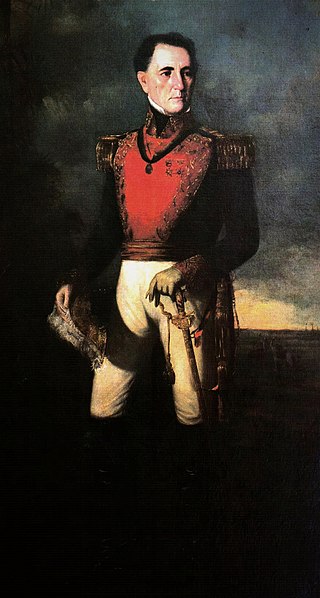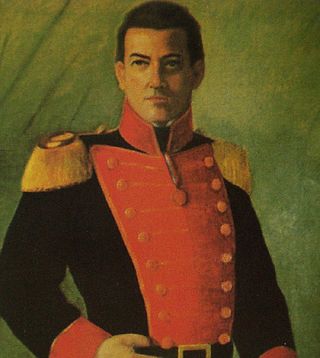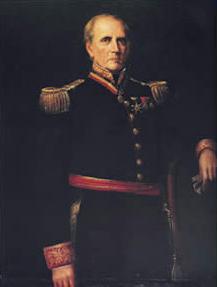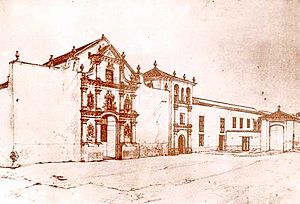
José Antonio Páez Herrera was a Venezuelan politician and military officer who served as the president of Venezuela three times. The first as the 5th president from 1830 to 1835, the second as the 8th president from 1839 to 1843, and the third as the 15th president from 1861 to 1863. He fought against the Spanish Crown for Simón Bolívar during the Venezuelan War of Independence. Páez later led Venezuela's independence from Gran Colombia.

José Tadeo Monagas Burgos was the president of Venezuela 1847–1851 and 1855–1858, and a hero of the Venezuelan War of Independence.

José Gregorio Monagas was the president of Venezuela 1851–1855 and brother of José Tadeo Monagas.

Julián Castro Contreras was a Venezuelan military officer and the president of Venezuela between 1858 and 1859.

Guillermo Tell Villegas was a Venezuelan politician, lawyer, and writer. Among other government positions, he served as interim president of Venezuela in 1868, 1870 and 1892. Starting his career in law, he became governor of Barinas in 1859 and afterwards held various roles in the government of Juan Crisostomo Falcon, including deputy in the Assembly of Victory, Minister of Interior and Justice, and interim Foreign Minister of Venezuela. In 1864 and in 1866 was appointed to the Federal High Court. Villegas participated in the La Genuina revolution in 1867, and was elected president of the Chamber of Deputies in 1868, where he openly opposed the government of Falcón. The Blue Revolution in 1868 removed Falcon from power, and Villegas became Foreign Minister under President José Ruperto Monagas. In 1868 Villegas spent eight months as interim president of Venezuela, during which time he reinstated the Federal Constitution from 1864. After again serving as interim president and Minister of the Interior in 1869, in 1870 he was interim president a third time while Monagas fought the Liberal Revolution. The revolution was successful, and Villegas retired from active politics after ceding the presidency.

Ezequiel Zamora was a Venezuelan soldier and leader of the Federalists in the Federal War (Guerra Federal) of 1859–1863.

General Juan Antonio Sotillo (1790–1878) was a nineteenth-century military leader from Venezuela. During his long life, uncommon for a military leader at the time, he served under the army of Venezuelan general Simón Bolívar, as well as in most of Venezuela's 19th century civil wars and military revolts.

The National Pantheon of Venezuela is a final resting place for national heroes. The Pantheon was created in the 1870s on the site of the ruined Santísima Trinidad church from 1744 on the northern edge of the old town of Caracas, Venezuela.

Santiago Mariño Carige Fitzgerald, was a nineteenth-century Venezuelan revolutionary leader and hero in the Venezuelan War of Independence (1811–1823). He became an important leader of eastern Venezuela and for a short while in 1835 seized power over the new state of Venezuela.

Fermín Toro y Blanco was a Venezuelan humanist, politician, diplomat and author.
Following the Venezuelan War of Independence, Venezuela initially won independence from the Spanish Empire as part of Gran Colombia. Internal tensions led to the dissolution of Gran Colombia in 1830/31, with Venezuela declaring independence in 1811. For the rest of the nineteenth century, independent Venezuela saw a range of caudillos (strongmen) compete for power. Leading political figures included José Antonio Páez, Antonio Guzmán Blanco and Cipriano Castro.
José Joaquín Herrera (1784-1868) was a Venezuelan military and politician, president of Carabobo from 1846 to 1854, and in 1855 he was appointed provisional president of Venezuela from 20 January 1855 until 30 January 1855 in the succession of power between José Gregorio Monagas and his brother José Tadeo Monagas. He served as the vice president of Venezuela from 1851 until 1855.

The State of Venezuela was the official name of Venezuela adopted by the constitution of 1830, during the government of José Antonio Páez. The name was maintained until 1856 when in the constitution promulgated in that year it changes the official name of the country to Republic of Venezuela. In the Constitution of 1864, the United States of Venezuela was established.
Francisco Hernáiz was a Venezuelan military officer and political figure during the 19th century. Born in Puerto Rico he achieved the rank of Rear admiral and performed his duty as Secretary of War and Navy during the governments of José Antonio Páez, José María Vargas and Carlos Soublette. His name figures among the Navy Forefathers of Venezuela.

La Cosiata, also known as the Revolution of the Morrocoyes, was a political separatist movement that broke out in the city of Valencia, Venezuela, carried out by General José Antonio Páez and Miguel Peña Páez on April 30, 1826, fighting for Venezuelan secession from Gran Colombia.
The Venezuelan civil wars were a long series of conflicts that devastated the country during most of the 19th century.
The Revolution of the Reforms was a military movement in Venezuela between June 7, 1835, and March 1, 1836, against the government of José María Vargas, the conservative Congress, and the influence of José Antonio Páez. It was led by outstanding independence heroes such as Santiago Mariño, Diego Ibarra, Pedro Briceño Méndez, José Laurencio Silva, José María Melo, Blas Bruzual, Luis Perú de Lacroix, Pedro Carujo, José Tadeo Monagas, Renato Beluche, Andrés Level de Goda, and Estanislao Rendon.

The Venezuelan peasant insurrection of 1846 was a popular and social rebellion that broke out in various agricultural areas of Venezuela in September 1846 and lasted until May 1847.The rebellion was suppressed by the Conservative army.
The civil war of 1848-1849 was an armed conflict in Venezuela between the conservatives, led by José Antonio Páez, against the newly established Great Liberal Party, founded and led by José Tadeo Monagas.

The March Revolution was a military uprising that took place in Venezuela in March 1858. It was the first armed rebellion that managed to overthrow a government in Venezuelan history. The principal leader, the caudillo Julián Castro, was trusted absolutely by President José Tadeo Monagas.














